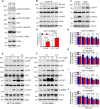Tumor acidosis-induced DNA damage response and tetraploidy enhance sensitivity to ATM and ATR inhibitors
- PMID: 38366255
- PMCID: PMC10933359
- DOI: 10.1038/s44319-024-00089-7
Tumor acidosis-induced DNA damage response and tetraploidy enhance sensitivity to ATM and ATR inhibitors
Abstract
Tumor acidosis is associated with increased invasiveness and drug resistance. Here, we take an unbiased approach to identify vulnerabilities of acid-exposed cancer cells by combining pH-dependent flow cytometry cell sorting from 3D colorectal tumor spheroids and transcriptomic profiling. Besides metabolic rewiring, we identify an increase in tetraploid cell frequency and DNA damage response as consistent hallmarks of acid-exposed cancer cells, supported by the activation of ATM and ATR signaling pathways. We find that regardless of the cell replication error status, both ATM and ATR inhibitors exert preferential growth inhibitory effects on acid-exposed cancer cells. The efficacy of a combination of these drugs with 5-FU is further documented in 3D spheroids as well as in patient-derived colorectal tumor organoids. These data position tumor acidosis as a revelator of the therapeutic potential of DNA repair blockers and as an attractive clinical biomarker to predict the response to a combination with chemotherapy.
Keywords: 3D Spheroids; ATM; DNA Damage Response; Organoids; Tumor Acidosis.
© 2024. The Author(s).
Conflict of interest statement
The authors declare no competing interests.
Figures










Similar articles
-
Inhibition of ATR-dependent feedback activation of Chk1 sensitises cancer cells to Chk1 inhibitor monotherapy.Cancer Lett. 2016 Dec 1;383(1):41-52. doi: 10.1016/j.canlet.2016.09.024. Epub 2016 Sep 28. Cancer Lett. 2016. PMID: 27693461
-
Selective Inhibition of ATM-dependent Double-strand Break Repair and Checkpoint Control Synergistically Enhances the Efficacy of ATR Inhibitors.Mol Cancer Ther. 2023 Jul 5;22(7):859-872. doi: 10.1158/1535-7163.MCT-22-0685. Mol Cancer Ther. 2023. PMID: 37079339 Free PMC article.
-
Pharmacologic inhibition of ATR and ATM offers clinically important distinctions to enhancing platinum or radiation response in ovarian, endometrial, and cervical cancer cells.Gynecol Oncol. 2015 Mar;136(3):554-61. doi: 10.1016/j.ygyno.2014.12.035. Epub 2015 Jan 2. Gynecol Oncol. 2015. PMID: 25560806 Free PMC article.
-
The development of ataxia telangiectasia mutated kinase inhibitors.Mini Rev Med Chem. 2014;14(10):805-11. Mini Rev Med Chem. 2014. PMID: 25138084 Review.
-
Versatility of the Mec1ATM/ATR signaling network in mediating resistance to replication, genotoxic, and proteotoxic stresses.Curr Genet. 2019 Jun;65(3):657-661. doi: 10.1007/s00294-018-0920-y. Epub 2019 Jan 5. Curr Genet. 2019. PMID: 30610294 Free PMC article. Review.
Cited by
-
Live Microscopy of Multicellular Spheroids with the Multimodal Near-Infrared Nanoparticles Reveals Differences in Oxygenation Gradients.ACS Nano. 2024 May 14;18(19):12168-12186. doi: 10.1021/acsnano.3c12539. Epub 2024 Apr 30. ACS Nano. 2024. PMID: 38687976 Free PMC article.
-
Resistance to neoadjuvant chemotherapy in breast cancers: a metabolic perspective.J Exp Clin Cancer Res. 2025 Aug 11;44(1):234. doi: 10.1186/s13046-025-03500-w. J Exp Clin Cancer Res. 2025. PMID: 40790759 Free PMC article. Review.
-
[Relationship between GTSE1 and Cell Cycle and Potential Regulatory Mechanisms in Lung Cancer Cells].Zhongguo Fei Ai Za Zhi. 2024 Jun 20;27(6):451-458. doi: 10.3779/j.issn.1009-3419.2024.106.13. Zhongguo Fei Ai Za Zhi. 2024. PMID: 39026496 Free PMC article. Review. Chinese.
-
Downregulated TRAF3IP2-AS1 promotes hepatocellular carcinoma progression through the miR-374a-5p/SEL1L1/RPL6 axis to enhance DNA damage repair.Am J Transl Res. 2025 Apr 15;17(4):2445-2466. doi: 10.62347/UJZK5358. eCollection 2025. Am J Transl Res. 2025. PMID: 40385018 Free PMC article.
References
MeSH terms
Substances
Grants and funding
LinkOut - more resources
Full Text Sources
Medical
Molecular Biology Databases
Research Materials
Miscellaneous

